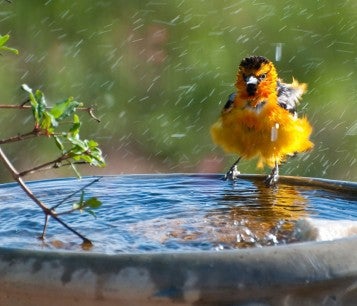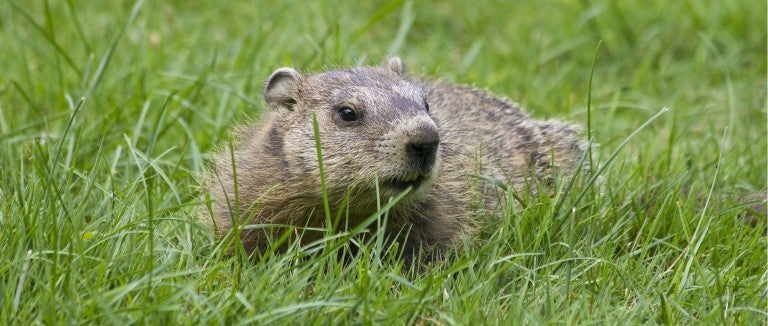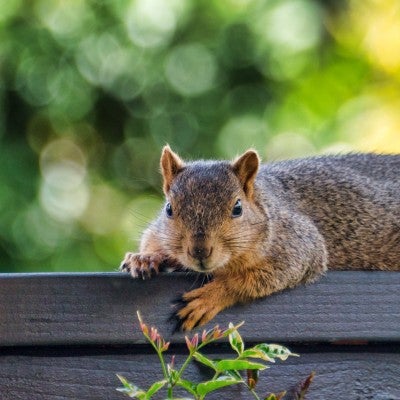Known for Groundhog Day and weather prediction, nearsighted groundhogs (aka woodchucks) have an important place in the ecosystem. They provide food for coyotes, foxes, weasels, badgers, hawks and eagles, and their burrows give shelter to amphibians, reptiles, rodents and foxes.
Just the possibility that groundhogs might cause problems one day is used as an excuse to "control" them, but people and groundhogs can coexist for years without conflict. If you have a groundhog burrow on your property and don't have any conflicts with its occupants, let it be. But if they’re eating more than their fair share of your crops or causing damage to your property, here’s how to handle them with kindness.
Contents
No matter how big or small your outdoor space, you can create a haven for local wildlife. By providing basic needs like water, food and shelter, you can make a difference in your own backyard.

What’s the best way to get rid of groundhogs?
Where groundhog burrows are deemed to be problems, the best course of action is to “evict” the groundhogs (get rid of them) and then “exclude” them (prevent them from coming back). The best time to evict groundhogs from burrows is from mid- to late summer or between early July and late September in most areas. Breeding female groundhogs have dependent young in their burrows from late winter until spring or early summer, and evicting them during this time can be inhumane. Moms will resist abandoning young, even under great duress. But if you wait too late in the year when groundhogs put on weight and secure a suitable location to hibernate, they may not survive the winter.
Check burrows
Before closing a burrow, first test for activity: Loosely plug all the burrow entrances (there may be several) with grass clippings or newspaper and monitor activity. If the material has not been disturbed after three to five days in clear summer weather, you can assume the burrow is unoccupied.
If the burrow system is occupied, harass the residents:
-
Partially dig the entrance out.
-
Clear vegetation away from entrances.
-
Put a harmless but strong-smelling substance just inside the entrance, such as urine-saturated clumps of kitty litter or a capsaicin-based repellent.
-
Loosely seal the entrance, so the smell stays inside the burrow.
-
Monitor the closed burrow every few days to make sure it's not still occupied; when it’s clear that the burrow is empty, you can permanently seal it.
Close burrows
Even when a burrow's entrance is barely recognizable, the groundhog's highly developed sense of smell allows them to locate places where others have lived months or even years before.
With only a few minutes' work, groundhogs can reopen a tunnel system and use it again. You can prevent this by burying a three-foot-square panel of welded wire centered over the entrance hole before an abandoned burrow is rediscovered. (Always ensure that the burrows are unoccupied first though!)
-
Use heavy-gauge, welded fencing wire (with no larger than three-inch squares) to close burrows.
-
Cut the wire into three-by-three foot sections.
-
Center a section over each burrow entrance.
-
Bury the fencing at least one foot deep.
-
Pin it down with landscape staples.
Keep monitoring not only closed burrows, but the rest of the yard, too. Immediately respond to any attempts to reopen old burrows or establish new ones to prevent new burrows from popping up.
Remove habitat
Groundhogs like to navigate through tall vegetation. Removing vegetation around burrows can create insecurity and, with other eviction methods applied simultaneously, can encourage groundhogs to abandon a burrow system, especially one that hasn't been used for long. Beyond that, keeping undergrowth and grass cover low around buildings will discourage groundhogs from burrowing there.
How can I stop groundhogs from eating my plants?
Groundhogs love eating peas, carrot tops, squash, lettuce, sunflowers and more, and they don’t know it’s not theirs for the munching. Luckily, these simple solutions can protect your flowers and crops.
Install fences
Even though groundhogs are good climbers, you can protect your gardens with fencing, which work best when protecting relatively small areas. To be a successful barrier, a perimeter garden fence should:
-
Be made of a chicken or welded wire with mesh size no bigger than three by three inches.
-
Reach three to four feet above ground level.
-
Wobble as the groundhog tries to climb it. (Leaving fence tops unsecured can make them nice and wobbly.)
-
Have an L-footer base that is buried or pinned to the ground or a single strand of electric fencing four inches off the ground and six inches in front of the fence to prevent digging.
If you are building a more rigid fence, bend the top ten to fifteen inches outward at a 45-degree angle to create a barrier to help prevent climbing.
Electric fences will work as well, and often a simple single strand of electrified wire set four inches above the ground is enough to discourage visits. If not, you can add one more strand about nine inches from the ground. Follow standard safety protocols when using electric fences.
Try scare devices
Groundhogs are cautious animals and can be frightened by new objects in the environment. Scare devices are more likely to work if they’re changed frequently. Try tying silver Mylar® helium balloons in the garden on a short line, so the wind occasionally bounces them onto the ground or suspend a beach ball in a place where it will catch the wind. These scare devices may keep them groundhogs temporarily, but are more likely to work if they are changed frequently.
What diseases do groundhogs carry?
Groundhogs are not a significant source of any infectious disease that can be transmitted to humans. However, like all mammals, they can get rabies. For this reason, unprovoked attacks by groundhogs must be treated very seriously as potential rabies exposures.

